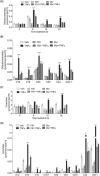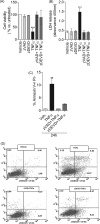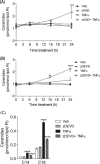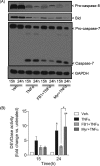Tumor Necrosis Factor-α (TNFα)-induced Ceramide Generation via Ceramide Synthases Regulates Loss of Focal Adhesion Kinase (FAK) and Programmed Cell Death
- PMID: 26318452
- PMCID: PMC4646185
- DOI: 10.1074/jbc.M115.658658
Tumor Necrosis Factor-α (TNFα)-induced Ceramide Generation via Ceramide Synthases Regulates Loss of Focal Adhesion Kinase (FAK) and Programmed Cell Death
Abstract
Ceramide synthases (CerS1-CerS6), which catalyze the N-acylation of the (dihydro)sphingosine backbone to produce (dihydro)ceramide in both the de novo and the salvage or recycling pathway of ceramide generation, have been implicated in the control of programmed cell death. However, the regulation of the de novo pathway compared with the salvage pathway is not fully understood. In the current study, we have found that late accumulation of multiple ceramide and dihydroceramide species in MCF-7 cells treated with TNFα occurred by up-regulation of both pathways of ceramide synthesis. Nevertheless, fumonisin B1 but not myriocin was able to protect from TNFα-induced cell death, suggesting that ceramide synthase activity is crucial for the progression of cell death and that the pool of ceramide involved derives from the salvage pathway rather than de novo biosynthesis. Furthermore, compared with control cells, TNFα-treated cells exhibited reduced focal adhesion kinase and subsequent plasma membrane permeabilization, which was blocked exclusively by fumonisin B1. In addition, exogenously added C6-ceramide mimicked the effects of TNFα that lead to cell death, which were inhibited by fumonisin B1. Knockdown of individual ceramide synthases identified CerS6 and its product C16-ceramide as the ceramide synthase isoform essential for the regulation of cell death. In summary, our data suggest a novel role for CerS6/C16-ceramide as an upstream effector of the loss of focal adhesion protein and plasma membrane permeabilization, via the activation of caspase-7, and identify the salvage pathway as the critical mechanism of ceramide generation that controls cell death.
Keywords: Ceramide; PTK2 protein tyrosine kinase 2 (PTK2) (focal adhesion kinase) (FAK); cell death; ceramide synthase; fumonisin b1; plasma membrane; sphingolipid.
© 2015 by The American Society for Biochemistry and Molecular Biology, Inc.
Figures











Similar articles
-
Ceramide synthase-dependent ceramide generation and programmed cell death: involvement of salvage pathway in regulating postmitochondrial events.J Biol Chem. 2011 May 6;286(18):15929-42. doi: 10.1074/jbc.M111.230870. Epub 2011 Mar 9. J Biol Chem. 2011. PMID: 21388949 Free PMC article.
-
Antiapoptotic roles of ceramide-synthase-6-generated C16-ceramide via selective regulation of the ATF6/CHOP arm of ER-stress-response pathways.FASEB J. 2010 Jan;24(1):296-308. doi: 10.1096/fj.09-135087. Epub 2009 Sep 1. FASEB J. 2010. PMID: 19723703 Free PMC article.
-
Folate stress induces apoptosis via p53-dependent de novo ceramide synthesis and up-regulation of ceramide synthase 6.J Biol Chem. 2013 May 3;288(18):12880-90. doi: 10.1074/jbc.M113.461798. Epub 2013 Mar 21. J Biol Chem. 2013. PMID: 23519469 Free PMC article.
-
Ceramide synthases at the centre of sphingolipid metabolism and biology.Biochem J. 2012 Feb 1;441(3):789-802. doi: 10.1042/BJ20111626. Biochem J. 2012. PMID: 22248339 Free PMC article. Review.
-
Ceramide and apoptosis: exploring the enigmatic connections between sphingolipid metabolism and programmed cell death.Anticancer Agents Med Chem. 2012 May;12(4):340-63. doi: 10.2174/187152012800228661. Anticancer Agents Med Chem. 2012. PMID: 21707511 Review.
Cited by
-
Elevated ceramides 18:0 and 24:1 with aging are associated with hip fracture risk through increased bone resorption.Aging (Albany NY). 2019 Nov 1;11(21):9388-9404. doi: 10.18632/aging.102389. Epub 2019 Nov 1. Aging (Albany NY). 2019. PMID: 31675352 Free PMC article.
-
Independent association of hypovitaminosis d with non-alcoholic fatty liver disease in people with chronic spinal cord injury: a cross-sectional study.J Endocrinol Invest. 2024 Jan;47(1):79-89. doi: 10.1007/s40618-023-02124-1. Epub 2023 Jun 5. J Endocrinol Invest. 2024. PMID: 37273143
-
BCAA insufficiency leads to premature ovarian insufficiency via ceramide-induced elevation of ROS.EMBO Mol Med. 2023 Apr 11;15(4):e17450. doi: 10.15252/emmm.202317450. Epub 2023 Feb 27. EMBO Mol Med. 2023. PMID: 36847712 Free PMC article.
-
Flupirtine derivatives as potential treatment for the neuronal ceroid lipofuscinoses.Ann Clin Transl Neurol. 2018 Aug 14;5(9):1089-1103. doi: 10.1002/acn3.625. eCollection 2018 Sep. Ann Clin Transl Neurol. 2018. PMID: 30250865 Free PMC article.
-
Ceramide-Induced Cell Death Depends on Calcium and Caspase-Like Activity in Rice.Front Plant Sci. 2020 Feb 26;11:145. doi: 10.3389/fpls.2020.00145. eCollection 2020. Front Plant Sci. 2020. PMID: 32161611 Free PMC article.
References
-
- Fulda S. (2009) Tumor resistance to apoptosis. Int. J. Cancer 124, 511–515 - PubMed
-
- Wyllie A. H., Kerr J. F., Currie A. R. (1980) Cell death: the significance of apoptosis. Int. Rev. Cytol. 68, 251–306 - PubMed
-
- Silva M. T. (2010) Secondary necrosis: the natural outcome of the complete apoptotic program. FEBS Lett. 584, 4491–4499 - PubMed
-
- Robertson A. M., Bird C. C., Waddell A. W., Currie A. R. (1978) Morphological aspects of glucocorticoid-induced cell death in human lymphoblastoid cells. J. Pathol. 126, 181–187 - PubMed
Publication types
MeSH terms
Substances
Grants and funding
LinkOut - more resources
Full Text Sources
Miscellaneous

